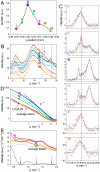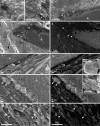Mapping amorphous calcium phosphate transformation into crystalline mineral from the cell to the bone in zebrafish fin rays
- PMID: 20308589
- PMCID: PMC2851957
- DOI: 10.1073/pnas.0914218107
Mapping amorphous calcium phosphate transformation into crystalline mineral from the cell to the bone in zebrafish fin rays
Abstract
The continuously forming fin bony rays of zebrafish represent a simple bone model system in which mineralization is temporally and spatially resolved. The mineralized collagen fibrils of the fin bones are identical in structure to those found in all known bone materials. We study the continuous mineralization process within the tissue by using synchrotron microbeam x-ray diffraction and small-angle scattering, combined with cryo-scanning electron microscopy. The former provides information on the mineral phase and the mineral particles size and shape, whereas the latter allows high-resolution imaging of native hydrated tissues. The integration of the two techniques demonstrates that new mineral is delivered and deposited as packages of amorphous calcium phosphate nanospheres, which transform into platelets of crystalline apatite within the collagen matrix.
Conflict of interest statement
The authors declare no conflict of interest.
Figures




References
-
- Weiner S. Transient precursor strategy in mineral formation of bone. Bone. 2006;39:431–433. - PubMed
-
- Grynpas MD, Omelon S. Transient precursor strategy or very small biological apatite crystals? Bone. 2007;41:162–164. - PubMed
-
- Olszta MJ, et al. Bone structure and formation: A new perspective. Mat Sci Eng R. 2007;58:77–116.
-
- Christoffersen J, Christoffersen MR, Kibalczyc W, Andersen FA. A contribution to the understanding of the formation of calcium phosphates. J Cryst Growth. 1989;94:767–777.
-
- Crane NJ, et al. Raman spectroscopic evidence for octacalcium phosphate and other transient mineral species deposited during intramembranous mineralization. Bone. 2006;39:434–442. - PubMed
Publication types
MeSH terms
Substances
LinkOut - more resources
Full Text Sources

